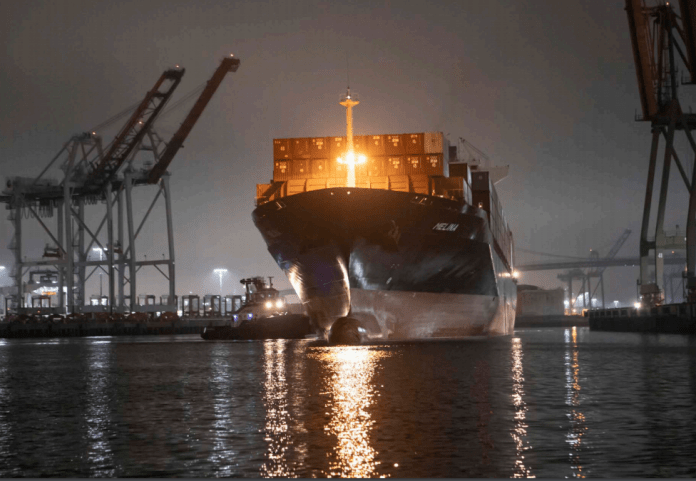The Port of Los Angeles (POLA) has reported a net reduction in air pollution during the previous year, eliminating its emissions after various swings in cargo volumes.
The Port’s Inventory of Air Emissions for 2020 reports that criteria pollutants fell slightly from 2019 levels, while diesel particulate matter (DPM) and sulfur oxides (SOx) were decreased by 1% and nitrogen oxides (NOx) saw a decline of 3%.
During the first five months of 2020, container traffic through the LA Port dropped by 19% due to the pandemic. However, in the third quarter, the container volumes grew by more than 50% through the remainder of the year, and the final months marked the start of ships going to anchorage awaiting their berth assignments. In total, more than 9.2 million TEU moved through POLA during last year – a slight drop from 2019, but still the fourth-busiest year in POLA’s history.
“The tremendous drop in emissions during the first part of 2020 offset the increase at the end of the year,” explained Port Director of Environmental Management, Christopher Cannon, who noted that “the cargo surge has continued well into this year, we expect to see an increase in emissions for the calendar year 2021.”
Furthermore, the ongoing industry trend of fewer ship calls due to larger vessels carrying more cargo continued in 2020, when the port welcomed 968 container ship calls in total —down 2% since 2019.
Since 2005, container ships calls have dropped 35% and now average 88% more TEU per vessel, according to the US port.
Another positive trend is the ongoing turnover of the nearly 19,000 trucks registered to call at the United States’ busiest port. Today, 40% of the truck drayage fleet was built in 2014 or they are newer models, a sign that companies doing business at the port invest in drayage trucks equipped with pollution control systems.
Likewise, railroads and terminal operators continue to upgrade locomotives and cargo handling equipment with cleaner engines. Nearly 28% of the 1,915 machines such as cranes, yard tractors and other off-road vehicles run on electricity or alternative fuels.
In addition, the US West Coast port focuses on eliminating tailpipe emissions from cargo handling equipment by 2030 and drayage trucks by 2035. Both goals are crucial for the Port’s larger goal of reducing port-related greenhouse gas (GHG) emissions 40% below 1990 levels by 2030 and 80% below 1990 levels by 2050.
The Californian port has already made progress in reducing GHG emissions, with the rate of reduction for 2020 reaching 12%. “The technology that reduces particulate matter and nitrogen oxides can sometimes increase greenhouse gases,” said Cannon, who added that “this makes our zero emissions demonstration projects all the more critical because they reduce both criteria pollutants and greenhouse gas levels.”
POLA has already achieved its 2023 Clean Air Action Plan (CAAP) goals for reducing emissions of DPM by 77%, NOx by 59% and SOx by 93% and it also continues to surpass its 2020 goal of reducing the health risk from port-related operations by 85% which was first achieved in 2014.
The port focuses on compliance with mandatory and voluntary pollution control reduction programs, driving down vessel emissions. The measures include switching to cleanest-available low-sulfur fuel, using incentives to attract the newest and cleanest ships to the port, as well as plugging most container, refrigerated cargo and cruise ships into shoreside electrical power at berth, according to a statement.
Currently, POLA is either leading or participating in 16 regional projects with multiple partners to demonstrate low NOx and zero-emissions trucks, yard tractors, forklifts and other equipment, according to a statement, while the large-scale pilots include alternative fueling and charging infrastructure.
An analysis of the port’s clean air gains on a per-container basis shows emissions reduction measures are paying off as the cargo volumes grow. However, the ongoing cargo surge in 2021 has caused delays likely to overturn some of the port’s clean air progress. Under the port’s standard protocol, at-anchorage emissions for all ships calling Los Angeles are included in the emissions inventory.
“Operational efficiency benefits both business and the environment,” pointed out Cannon who explained that the heavy volume of inbound cargo has led to disruptions across the supply chain, and those impacts will be reflected in next year’s inventory.
The annual inventory measures the progress of the port’s strategies for reducing pollution from all sources related to its operations and compares the data with emissions levels from the previous year, as well as the year of 2005 which constitutes the inventory’s baseline year.
Port-related emissions are tracked across much of the South Coast Air Basin and surrounding coastal waters, and therefore regional, state and federal air regulatory agencies review the annual report to ensure if the port’s methodologies are accurate.







